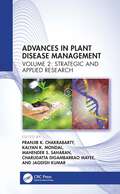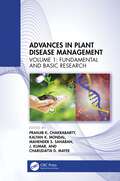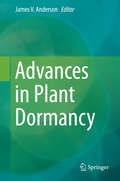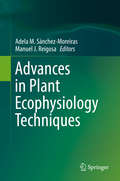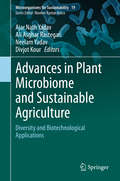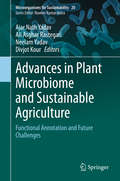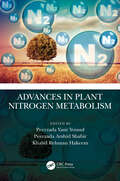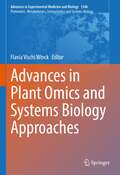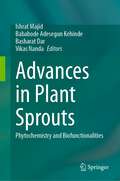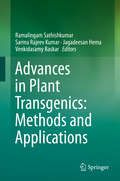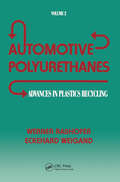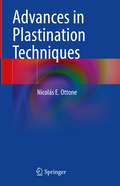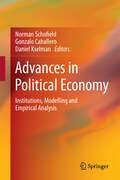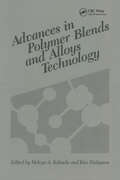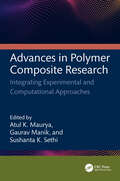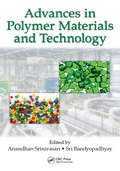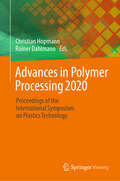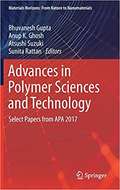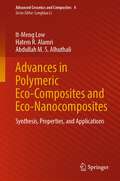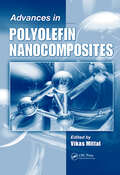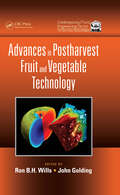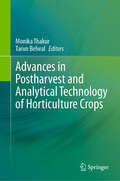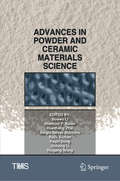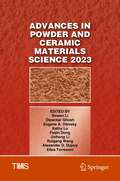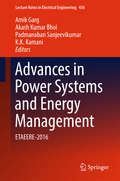- Table View
- List View
Advances in Plant Disease Management Volume II: Strategic and Applied Research
by Pranjib K. Chakrabarty Kalyan K. Mondal Mahender S. Saharan Charudatta Digambarrao Mayee Jagdish KumarAdvances in Plant Disease Management: Volume II: Strategic and Applied Research is an invaluable compilation for researchers/students/stakeholders/policymakers in agriculture. This book aims to offer the latest understanding of how fundamental and basic research can be translated toward the engineering of biotic stress-resilient crops through applied and strategic management of plant diseases. Volume I clearly explained the updated knowledge on basic and applied phenomena of pathogen’s interplay with the host, the host immune system, crosstalks among downstream regulating molecules as unraveled through genomics, proteomics, metabolomics, bioinformatics, and molecular studies. This volume of the book equips readers with the knowledge and understanding to confidently employ this basic information in the formulation of management strategies for major crop plant diseases.This book offers comprehensive coverage of the research advances in plant disease management, including: Newer insight into pest risk analysis (PRA) and its significance in international trade. Developments in eco-friendly green technologies that are safe for both humans and the environment to manage diseases. Use of AI tools for diagnosis, development of models for advanced prediction of the outbreak of epidemics, and need-based application of agrochemicals and their appropriate formulations for use through drones. The information regulation and use of biostimulants for biotic and abiotic resilience. Plant protection policies that support the agricultural production system from a global perspective.
Advances in Plant Disease Management: Volume I: Fundamental and Basic Research
by Pranjib K. ChakrabartyAdvances in Plant Disease Management: Volume I: Fundamental and Basic Research is an invaluable compilation for researchers/students/stakeholders/policymakers in agriculture. The book aims to offer the latest understanding of fundamental and basic research fronts toward managing crop plants diseases. After clearly explaining the updated knowledge on the host immune system, and pathogen’s interplay with the host as unraveled through genomics, bioinformatics, and molecular studies, this book equips readers with the knowledge to confidently account for them during the formulation of management strategies for major crop plant diseases. The book offers comprehensive coverage of the research advances in plant disease management, including: Newer insight into the host-pathogen interaction, including effector-driven pathogenesis in different host-pathogen systems Updates on plant defense pathways leading to resistance to pathogens Use of novel molecules, antagonists, and genome-editing tools toward manipulating host resistance Plant protection policies that support the agricultural production system from a global perspective
Advances in Plant Dormancy
by James V. AndersonPlant dormancy involves synchronization of environmental cues with developmental processes to ensure plant survival; however, negative impacts of plant dormancy include pre-harvest sprouting, non-uniform germination of crop and weed seeds, and fruit loss due to inappropriate bud break. Thus, our continued quest to disseminate information is important in moving our understanding of plant dormancy forward and to develop new ideas for improving food, feed, and fiber production and efficient weed control, particularly under global climate change. Proceeding from the 5th International Plant Dormancy Symposium will provide an overview related on our current understanding of how environmental factors impact cellular, molecular, and physiological processes involved in bud and seed dormancy, and perspectives and/or reviews on achievements, which should stimulate new ideas and lines of investigation that increase our understanding of plant dormancy and highlight directions for future research.
Advances in Plant Ecophysiology Techniques
by Adela M. Sánchez-Moreiras Manuel J. ReigosaThis handbook covers the most commonly used techniques for measuring plant response to biotic and abiotic stressing factors, including: in vitro and in vivo bioassays; the study of root morphology, photosynthesis (pigment content, net photosynthesis, respiration, fluorescence and thermoluminiscence) and water status; thermal imaging; the measurement of oxidative stress markers; flow cytometry for measuring cell cycle and other physiological parameters; the use of microscope techniques for studying plant microtubules; programmed-cell-death; last-generation techniques (metabolomics, proteomics, SAR/QSAR); hybridization methods; isotope techniques for plant and soil studies; and the measurement of detoxification pathways, volatiles, soil microorganisms, and computational biology.
Advances in Plant Microbiome and Sustainable Agriculture: Diversity and Biotechnological Applications (Microorganisms for Sustainability #19)
by Ajar Nath Yadav Ali Asghar Rastegari Neelam Yadav Divjot KourMicrobes are ubiquitous in nature, and plant-microbe interactions are a key strategy for colonizing diverse habitats. The plant microbiome (epiphytic, endophytic and rhizospheric) plays an important role in plant growth and development and soil health. Further, rhizospheric soil is a valuable natural resource, hosting hotspots of microbes, and is vital in the maintenance of global nutrient balance and ecosystem function. The term endophytic microbes refers to those microorganisms that colonize the interior the plants. The phyllosphere is a common niche for synergism between microbes and plants and includes the leaf surface. The diverse group of microbes are key components of soil-plant systems, and where they are engaged in an extensive network of interactions in the rhizosphere/endophytic/phyllospheric they have emerged as an important and promising tool for sustainable agriculture. Plant microbiomes help to directly or indirectly promote plant growth using plant growth promoting attributes, and could potentially be used as biofertilizers/bioinoculants in place of chemical fertilizers. This book allows readers to gain an understanding of microbial diversity associated with plant systems and their role in plant growth, and soil health. Offering an overview of the state of the art in plant microbiomes and their potential biotechnological applications in agriculture and allied sectors, it is a valuable resource for scientists, researchers and students in the field of microbiology, biotechnology, agriculture, molecular biology, environmental biology and related subjects.
Advances in Plant Microbiome and Sustainable Agriculture: Functional Annotation and Future Challenges (Microorganisms for Sustainability #20)
by Ajar Nath Yadav Ali Asghar Rastegari Neelam Yadav Divjot KourMicrobes are ubiquitous in nature, and plant-microbe interactions are a key strategy for colonizing diverse habitats. The plant microbiome (epiphytic, endophytic and rhizospheric) plays an important role in plant growth and development and soil health. Further, rhizospheric soil is a valuable natural resource, hosting hotspots of microbes, and is vital in the maintenance of global nutrient balance and ecosystem function. The term endophytic microbes refers to those microorganisms that colonize the interior the plants. The phyllosphere is a common niche for synergism between microbes and plants and includes the leaf surface. The diverse group of microbes are key components of soil-plant systems, and where they are engaged in an extensive network of interactions in the rhizosphere/endophytic/phyllospheric they have emerged as an important and promising tool for sustainable agriculture. Plant microbiomes help to directly or indirectly promote plant growth using plant growth promoting attributes, and could potentially be used as biofertilizers/bioinoculants in place of chemical fertilizers. This book allows readers to gain an understanding of microbial diversity associated with plant systems and their role in plant growth, and soil health. Offering an overview of the state of the art in plant microbiomes and their potential biotechnological applications in agriculture and allied sectors, it is a valuable resource for scientists, researchers and students in the field of microbiology, biotechnology, agriculture, molecular biology, environmental biology and related subjects.
Advances in Plant Nitrogen Metabolism
by Khalid Rehman Hakeem Peerzada Yasir Yousuf Arshid Shabir, and , PeerzadaAdvances in Plant Nitrogen Metabolism is a thoughtful, provocative, and up-to-date volume that presents important physiological, biochemical, and molecular perspectives of the nitrogen metabolism in plants and regulatory networks underlying it. The book is an attempt to team up with global leading research experts working in the field of plant nitrogen metabolism to compile an up-to-date and wide-ranging volume. The main purpose of this book is to present information on the most recent developments including the different modern approaches and methodologies that are being currently employed in the field of plant nitrogen metabolism. We trust that this comprehensive volume will familiarize readers with the detailed mechanisms of nitrogen metabolism and its regulation and the current trends in this field of study. The book offers comprehensive coverage of the most essential topics, including: Role of nitrogen and its assimilation in plants Recycling and remobilization of nitrogen during senescence Role of phytohormones in nitrogen metabolism Biological nitrogen fixation Nitrogen biofertilizers: role in sustainable agriculture Effect of stress on plant nitrogen metabolism Reactive nitrogen species (RNS) in plants Nitrogen toxicity in plants, symptoms, and safeguards Nitrogen metabolism enzymes: structure, role, and regulation Regulatory RNAs and their role in nitrogen metabolism of diazotrophs As a pivotal contribution to the field, this volume is an invaluable and up-to-date foundation for plant physiologists, plant biochemists, geneticists, molecular biologists, agronomists, environmental researchers, and students of plant science. The book can also be used for the coursework of research and master's students.
Advances in Plant Omics and Systems Biology Approaches (Advances in Experimental Medicine and Biology #1346)
by Flavia Vischi WinckIn the post-genomic era, several plant species have been sequenced and massive genomic information is now available which contributed to expand the development of novel technical strategies for the study of additional levels of biological information of plant species. This book focuses on the “omics” approaches together with systems analysis of several different plant species, which have revealed very interesting variations on the cellular responses at the protein, transcript and metabolite levels in response to changes environmental conditions. The volume covers recent technological advances in the area of “omics” and synthesizes recent findings of the field of plant “omics” and systems biology together along with techniques that can be applied for such studies.
Advances in Plant Sprouts: Phytochemistry and Biofunctionalities
by Vikas Nanda Ishrat Majid Bababode Adesegun Kehinde Basharat DarThe demand for plant foods in all global markets has been increasing along with awareness of greenhouse gases generated from animal farming, expanded sentiments against animal slaughtering and common perception of the health benefits of plant food products. Accordingly, more attention has been placed on green processing of plant foods for the optimization of their nutritional and health benefits. Sprouted vegetable products have been studied and reported in many scientific investigations to qualitatively improve the phytochemistry, enhance the nutritional profile and improve the biological functionality potentials of such vegetables beyond their initial natural states. Vegetable sprouts have been reported to possess aspects that make them serviceable for the management of metabolic syndrome disorders such as diabetes, hypertension, cancer and other health issues related to cellular oxidation of body cells, and antimicrobial bioactive components have been isolated from vegetable sprouts. Advances in Plant Sprouts: Phytochemistry and Biofunctionalities provides a singular source on recent advances in studies about the dietetic and nutraceutical potencies of vegetable sprouts and increases awareness on the possibility of processing plant foods to make them more nutritionally beneficial. Green production is another important aspect of this text since plant foods processed by sprouting are free of agrochemicals, consume less energy and utilize less manpower, making them easy to produce and environmentally friendly as well. Consumption and production of sprouted vegetables has been increasing in recent years, and this text covers the production and nutritional aspects of all the major sprout groups.
Advances in Plant Transgenics: Methods and Applications
by Ramalingam Sathishkumar Sarma Rajeev Kumar Jagadeesan Hema Venkidasamy BaskarThe green revolution led to the development of improved varieties of crops, especially cereals, and since then, classical or molecular breeding has resulted in the creation of economically valuable species. Thanks to recent developments in genetic engineering, it has become possible to introduce genes from different sources, such as bacteria, fungi, viruses, mice and humans, to plants. This technology has made the scientific community aware of the critical role of transgenics, not only as a means of producing stress tolerant crops but also as a platform for the production of therapeutics through molecular farming. This book discusses the commercial applications of plant transgenic technologies, including the use of transgenic cell culture approachesto improve the production of metabolites and high-value therapeutics as well as transgenic plants in pest management. It also explores generation of novel vectors, protein production using chloroplast engineering and the latest developments in this area, such as genome editing in plants. Featuring general discussions and research papers by leading international experts, it is a valuable resource for scientists, teachers, students and industrialists working in the field.
Advances in Plastics: Automotive Polyurethanes, Volume II
by Werner Rasshofer Eckehard WeigandThe technology for the recovery, reprocessing and reuse of automotive polyurethanes in Europe is highly developed and serves as a successful example for other areas. This new book by a leading authority on this technology details the materials and methods, as well as the problems, involved in this work. Going beyond recovery, the authors examine the processes and applications involved in putting recovered material to economic use in marketable products. The text is supplemented with more than 60 tables providing useful data on polyurethane recycling processes and chemistry. More than 60 photographs, micrographs, diagrams and flowcharts illustrate materials, processes and products. In addition to a detailed presentation of this technology, the book provides a review of European regulation and programs dealing with automotive plastics recycling, as well as the voluntary activities of industry organizations and individual companies. The information in this new book will be useful to personnel involved in the research, development and recycling of plastics and other polymeric materials for automotive applications. The details of reprocessing chemistry will be especially useful to polymer chemists working with polyurethanes. TablesMuch of the technical data in this book is presented in 64 tables. Here is a small sample of this material: o Plastic Components in Used Cars… o Reaction conditions for glycolysis of the Bayflex 110-80 System o Parameters of the Continuous Pebra-Magna Glycolysis Process o Physical Properties of RIM Polyurethanes Obtained by Using Glycolysis Polyols (20% Filler) o Comparison of the Mechanical Properties Baydur® STR from Virgin Polyol and from 70% RRIM Recycled Polyol o Flame Retardant Behavior of Adhesive-Pressed Boards Based on EA Foam Illustrations More than 60 photographs, micrographs, flowcharts and diagrams illustrated processes and materials, including finished products made of recycled polyurethanes. Here is a
Advances in Plastination Techniques
by Nicolás E. OttonePlastination is currently considered one of the most innovative forms of conservation of complete bodies, sections and organs, both human and animal, for use in undergraduate and postgraduate teaching, as well as morphological research. In this sense, to develop the various plastination techniques, specific equipment and specialized training of academics are required, who have the ability to carry out the diversity of protocols that exist, depending on the anatomical material to be preserved. The decomposition of organic matter is a vital process in nature, but it is also an impediment to morphological studies and research. This is particularly important in biological specimens that shrink considerably when exposed to normal atmospheric conditions. For this reason, it has always been a constantly pursued objective for anatomists. Plastination, in this regard, is a true alternative in the conservation of perishable biological tissues (complete bodies, complete organs such as brains, livers, lungs, kidneys, hearts, muscles, joint preparations, cuts in sections of complete corpses) - or from isolated regions, etc.) reaching a dry and imperishable state through the use of different polymers and special plastics, ensuring that the organs, limbs and entire bodies do not lose their texture and apparently normal disposition. This original book describes in detail and in an updated way the plastination techniques for the conservation of human and animal biological material, demonstrating the applications in teaching and research of anatomy, morphological sciences and health sciences. The didactic chapters present the history and the fundamentals of plastination techniques (steps, equipment, supplies, material, temperature), as well as its clinical, surgical and research applications. The work also features biosafety issues and provides Ethical Considerations in Plastination. Advances in Plastination Techniques is intended for a cross-section of academics, technicians and advanced students from all areas of Health Sciences - including Physicians and Dentists - and Veterinary Sciences.
Advances in Political Economy: Institutions, Modelling and Empirical Analysis
by Norman Schofield Daniel Kselman Gonzalo CaballeroThis book presents latest research in the field of Political Economy, dealing with the integration of economics and politics and the way institutions affect social decisions. The focus is on innovative topics such as an institutional analysis based on case studies; the influence of activists on political decisions; new techniques for analyzing elections, involving game theory and empirical methods.
Advances in Polymer Blends and Alloys Technology, Volume II
by Kier FinlaysonFrom Reports in Volume 5: "Recently polymer blends have emerged as one of the most important areas of research activity in the field of polymer science and technology. Because of their satisfactory performance in meeting specific needs of the polymer industry, they have drawn considerable attention in replacing not only many conventional materials, but also some of the polymers that are in vogue. By suitably varying the blend compositions and manipulating the processing conditions, tailor-made products with a unique set of end use properties can be achieved at a much lower cost and within a shorter time than would have been necessary for the development of a new polymer. The usefulness of such blends increases with the increasing range of applications of this type of materials." (Chapter 4) "New and growing demands on polymeric materials cannot be satisfied in future by an assortment extension of basic polymers. Although the introduction of new major-use basic polymer is possible, it seems unlikely in view of current projected economic and technical considerations. On the other hand, new products based on the modification of existing polymers have and will continue to be fruitful areas for both scientific and commercial developments. The driving forces for these developments are: 1. Improved performance, 2. Reduced cost, 3. Present, pending and future legislation dealing with health and environmental issues." (Chapter 11)
Advances in Polymer Composite Research: Integrating Experimental and Computational Approaches
by Gaurav Manik Sushanta K. Sethi Atul K. MauryaThis book emphasizes the importance of experimental characterization techniques and computational modeling tools in polymer composites. The topics covered include finite element analysis, computational fluid dynamics, molecular dynamics simulations, machine learning, material informatics, multiscale modeling, advanced characterization techniques, and the emerging field of nanocomposites. Each chapter provides detailed discussions, case studies, and examples to illustrate the practical application of these techniques in polymer composite research.Features: Offers a comprehensive exploration of polymer composites encompassing both experimental and computational approaches. Showcases most recent findings, methodologies, technologies, and applications in the field. Explores real-world case studies, industrial applications, and potential commercialization opportunities. Discusses the understanding, analysis, and design of polymer composites. Includes LAMMPS-, Ansys-, ABAQUS-, and Materials Studio-based simulation examples. This book is aimed at graduate students and researchers in polymers, polymer composites, and materials science.
Advances in Polymer Materials and Technology
by Anandhan Srinivasan Sri BandyopadhyayThis book covers recent advancements in the field of polymer science and technology. Frontiers areas, such as polymers based on bio-sources, polymer based ferroelectrics, polymer nanocomposites for capacitors, food packaging and electronic packaging, piezoelectric sensors, polymers from renewable resources, superhydrophobic materials and electrospinning are topics of discussion. The contributors to this book are expert researchers from various academic institutes and industries from around the world.
Advances in Polymer Processing 2020: Proceedings of the International Symposium on Plastics Technology
by Christian Hopmann Rainer DahlmannThis book gathers the proceedings of the International Symposium on Plastics Technology, which was held on March 10, 2020 in Aachen, Germany, and was organised by the Institute for Plastics Processing (IKV) in Industry and Craft at RWTH Aachen University. Peer-reviewed by an international scientific committee, the conference proceedings comprise the papers presented by the international speakers. Topics covered include - circular economy- extrusion- lightweight technologies- simulation and digitisation - injection moulding- hybrid materials and additive manufacturing. In these fields, key themes for plastics technologies have been identified that will shape the face of research and industry for the next decade. In their contributions, the authors present the latest scientific findings, and discuss topical issues in plastics technologies. The symposium offered an inspiring forum for the exchange on research and innovation, for discussing urgent questions and providing impulses for the future of plastics technology.
Advances in Polymer Sciences and Technology: Select Papers from APA 2017 (Materials Horizons: From Nature to Nanomaterials)
by Anup K. Ghosh Sunita Rattan Bhuvanesh Gupta Atsushi SuzukiThis book presents select papers presented at the annual meeting of the Asian Polymer Association. The chapters in this volume document and report on a wide range of significant recent results for various applications, as well as scientific developments in the areas of polymer science and engineering. The chapters include original research from all areas of polymer science and technology with a focus on the manufacture, processing, analysis and application of long chain polymer molecules. This book will be of interest to researchers in academia and industry alike.
Advances in Polymeric Eco-Composites and Eco-Nanocomposites: Synthesis, Properties, and Applications (Advanced Ceramics and Composites #4)
by It-Meng Low Hatem R. Alamri Abdullah M. AlhuthaliThis book provides an overview on the latest advances in the synthesis, properties and applications of polymeric eco-composites and eco-nanocomposites reinforced natural fibers (e.g. pulp-fiber, flax, etc.) and nanofillers (e.g. organoclay, nano-SiC, etc.). Potential challenges and future directions of these composites are highlighted and addressed. This book offers numerous graphs and electron micrographs for easy understanding by students, researchers and practicing engineers.
Advances in Polyolefin Nanocomposites
by Vikas MittalWith the advent of polymer nanocomposites, research on polyolefin nanocomposites has grown exponentially. Correcting the deficiency of a meaningful text on these important materials, Advances in Polyolefin Nanocomposites:Sums up recent advances in nanoscale dispersion of filler in polyolefinsPresents a basic introduction to polyolefin nanocomposite
Advances in Postharvest Fruit and Vegetable Technology (Contemporary Food Engineering Ser.)
by John Golding Ron B.H. WillsAdvances in Postharvest Fruit and Vegetable Technology examines how changes in community attitudes and associated pressures on industry are demanding changes in the way technology is used to minimize postharvest loss and maintain product quality. In particular, the book discusses important drivers for change, including:Using more natural chemicals
Advances in Postharvest and Analytical Technology of Horticulture Crops
by Monika Thakur Tarun BelwalThis book discusses advances in postharvest and analytical technology for horticulture crops and challenges to meet future needs. The horticulture crops (fruits and vegetables) need a systematic and scientific postharvest handling and management system for securing both physical and chemical attributes while prolonging their shelf life. Postharvest technologies include storage, drying, packaging, extraction of components, and preparation of juice and wine from the collected fruits and vegetables. All these postharvest technologies have emerged and evolved with time to provide meaningful solutions to minimize food loss, maintain quality, and provide fast processing of horticulture crops. Parallel development of analytical techniques has also evolved to monitor the quality of fruits and vegetables during postharvest processing and thus provide a rapid and efficient method for delivering safer food products. This book provides an overview of different postharvest technologies, their mechanisms, and their effect on the quality of horticulture crops. It also emphasizes the assessment of each advanced technology, including its limitations and advantages. Overall, this book provides techniques, research, mechanisms, advances, and challenges of postharvest and analytical technologies for horticulture crops, along with recommendations for future research directions.
Advances in Powder and Ceramic Materials Science (The Minerals, Metals & Materials Series)
by Sergio Neves Monteiro Bowen Li Faqin Dong Shefford P. Baker Huazhang Zhai Rajiv Soman Jinhong Li Ruigang WangThis collection emphasizes the advances of powder and ceramic materials in fundamental research, technology development, and industrial applications. Ceramic materials science covers the science and technology of creating objects from inorganic, nonmetallic materials, and includes design, synthesis, and fabrication of ceramics, glasses, advanced concretes, and ceramic-metal composites.
Advances in Powder and Ceramic Materials Science 2023 (The Minerals, Metals & Materials Series)
by Kathy Lu Bowen Li Faqin Dong Eugene A. Olevsky Jinhong Li Ruigang Wang Dipankar Ghosh Alexander D. Dupuy Elisa TorresaniThis collection emphasizes the advances of powder and ceramic/glass materials in the fundamental research, technology development, and industrial applications. Ceramic materials science covers the science and technology of creating objects from inorganic, non-metallic materials, and includes design, synthesis, and fabrication of ceramics, glasses, advanced concretes, and ceramic-metal composites. In recent years, the hybrids of ceramic and metallic materials have received plenty of interdisciplinary inspirations and achievements in material processes and functional applications including ionic conductors, catalysis, energy conversion and storage, superconductors, semiconductor, filtrations, etc. Topics cover, but are not limited to:· Silicates, oxides, and non-oxide ceramics and glasses · Synthesis, characterization, modeling, and simulation of ceramic materials · Design and control of ceramic microstructure and properties · Ceramic powders and processing · Catalyst and catalyst support materials · Fundamental understanding of ceramic materials and processes · Novel methods, techniques, and instruments used to characterize ceramics and glasses · High entropy ceramics (and/or entropy stabilized, complex-concentrated, compositionally-complex, multi-principal cation ceramics) · Bioceramics, electronic, magnetic ceramics, and applications · Surface treatment and ceramic thin films, membranes, and coatings · Porous ceramic materials · Hybrid systems of ceramic, metal, and/or polymer composites · Ceramics used for extreme environments · Metallurgical byproducts for ceramic manufacturing
Advances in Power Systems and Energy Management: ETAEERE-2016 (Lecture Notes in Electrical Engineering #436)
by Akash Kumar Bhoi Amik Garg Padmanaban Sanjeevikumar K. K. KamaniThis book is a collection of research articles and critical review articles, describing the overall approach to energy management. The book emphasizes the technical issues that drive energy efficiency in context of power systems. This book contains case studies with and without solutions on modelling, simulation and optimization techniques. It covers some innovative topics such as medium voltage (MV) back-to-back (BTB) system, cost optimization of a ring frame unit in textile industry, rectenna for radio frequency (RF) energy harvesting, ecology and energy dimension in infrastructural designs, 2. 4 kW three-phase inverter for aircraft application, study of automatic generation control (AGC) in a two area hydrothermal power system, energy-efficient and reliable depth-based routing protocol for underwater wireless sensor network, and power line communication using LabVIEW. This book is primarily targeted at researchers and senior graduate students, but is also highly useful for the industry professional and scientists.
